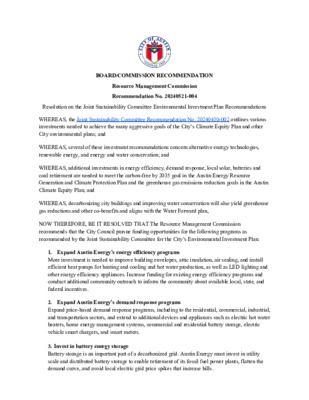Recommendation No. 20240521-004: Joint Sustainability Committee Environmental Investment Plan Recommendations — original pdf
Recommendation

BOARD/COMMISSION RECOMMENDATION Resource Management Commission Recommendation No. 20240521-004 Resolution on the Joint Sustainability Committee Environmental Investment Plan Recommendations WHEREAS, the Joint Sustainability Committee Recommendation No. 20240430-002 outlines various investments needed to achieve the many aggressive goals of the City’s Climate Equity Plan and other City environmental plans; and WHEREAS, several of these investment recommendations concern alternative energy technologies, renewable energy, and energy and water conservation; and WHEREAS, additional investments in energy efficiency, demand response, local solar, batteries and coal retirement are needed to meet the carbon-free by 2035 goal in the Austin Energy Resource Generation and Climate Protection Plan and the greenhouse gas emissions reduction goals in the Austin Climate Equity Plan; and WHEREAS, decarbonizing city buildings and improving water conservation will also yield greenhouse gas reductions and other co-benefits and aligns with the Water Forward plan, NOW THEREFORE, BE IT RESOLVED THAT The Resource Management Commission recommends that the City Council pursue funding opportunities for the following programs as recommended by the Joint Sustainability Committee for the City’s Environmental Investment Plan: 1. Expand Austin Energy’s energy efficiency programs More investment is needed to improve building envelopes, attic insulation, air sealing, and install efficient heat pumps for heating and cooling and hot water production, as well as LED lighting and other energy efficiency appliances. Increase funding for existing energy efficiency programs and conduct additional community outreach to inform the community about available local, state, and federal incentives. 2. Expand Austin Energy’s demand response programs Expand price-based demand response programs, including to the residential, commercial, industrial, and transportation sectors, and extend to additional devices and appliances such as electric hot water heaters, home energy management systems, commercial and residential battery storage, electric vehicle smart chargers, and smart meters. 3. Invest in battery energy storage Battery storage is an important part of a decarbonized grid. Austin Energy must invest in utility scale and distributed battery storage to enable retirement of its fossil fuel power plants, flatten the demand curve, and avoid local electric grid price spikes that increase bills. 4. Utility-owned or contracted rooftop solar Austin Energy needs a considerable expansion of local solar to meet energy needs and keep bills affordable. Land is expensive, so rooftop solar is the best locally available clean renewable energy source. Consider designing a program whereby Austin Energy invests directly in customers’ rooftop solar and owns the installation for a set period of time. 5. Shut down/retire AE’s portion of Fayette coal plant Austin Energy and LCRA co-own two coal-burning units at Fayette. Austin Energy’s portion accounts for about 25% of the entire Austin Energy’s scope 1 and 2 emissions (current GHG inventory). It is impossible to reach near, medium or long-term GHG reduction goals without closing Austin Energy’s portion of Fayette. 6. Air sealing task force and training program According to RMI and DOE, air sealing is the lowest cost path to lowering operational carbon. Air sealing is a sequencing and trade knowledge problem, not a technical or product problem, so training up our trade base is the best way to ensure higher quality, more air sealed buildings. Austin Energy should host trainings for trades on how to execute tight building envelopes, securing grants and federal funds for such programs. 7. Decarbonizing municipal buildings Retrofitting existing municipal buildings to reduce energy use, decarbonize them and make them more resilient will benefit the City budget and the services offered to the community. In addition to energy efficiency upgrades to meet suggested 2030 EUI reduction, where appropriate buildings should have solar installed, be equipped to participate in demand response programs, utilize electric appliances, connect to the City’s reclaimed water system, and employ sustainable and low-embodied carbon materials. Energy modeling and life cycle assessments should be done for all retrofits and new construction for municipal buildings. 8. Increase investments in water leak detection programs Austin Water should increase its annual detection and repair budget. In 2023, Austin Water lost 8,678,000,000 gallons of water which equates to a 21.68 gallons per capita per day of water loss. While this loss is within the acceptable loss for water utilities as set by the American Water Works Association (AWWA), there is a lot of room to make significant improvements. 9. Improve rebates for residential and commercial landscape conversions While ordinances for new construction can help reduce the amount of turf areas, existing properties don’t have requirements to adapt their landscapes to conserve water. Austin Water should offer more substantial and accessible rebates for landscape conversions. A tiered rebate structure that offers a higher per square foot incentive for smaller lots should be considered. Vote: 8-0 For: Commissioner Louis Stone, Chair; Commissioner Paul Robbins, Vice Chair; Commissioner Charlotte Davis; Commissioner Trey Farmer; Commissioner Shane Johnson; Commissioner Chelsey Scaffidi; Commissioner Alison Silverstein Against: None Abstentions: None Off Dais: None Absences: Commissioner GeNell Gary Vacancies: District 2 and Mayor’s Office Attest: Natasha Goodwin, Staff Liaison